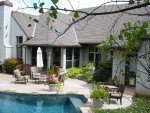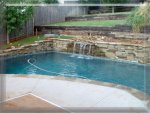I am new to the forum and would like opinions on what I may want to do with my water.
Pool info:
21,000 gal Fiberglass
Indoor with auto cover that is on all the time
Auto Pilot Total Control System(salt/chlorine generator)
Sta-rite Mod Media 3 Cartridge Filter
Pool is kept at 83 deg and heated to 88+ sometimes
Test Kit info:
Taylor K-2006C service complete (FAS-DPD chlorine)
Taylor K-1766 sodium chloride (salt water)
Auto Pilot Total Control reads:
ORP 659 high
PH 7.17 low
salt 3000
Taylor kits read:
FC .2
CC .8
PH 7.1 (says add 2lb soda ash)
Alkalinity 120
Calcium Hardness 400
CYA (I couldn't get a reading because the solution never turned cloudy)
Sodium Chloride 3000
I've been adding ProTeam Metal Magic on occasion to help with the brown stains.
Problem....I have some BLACK spots/stains appearing on my water line tile grout(silicone) as well as my perimiter fiber optic cable. I can't seem to get them to clean off.
Any suggestions are appreciated! Thanks, Andy
Pool info:
21,000 gal Fiberglass
Indoor with auto cover that is on all the time
Auto Pilot Total Control System(salt/chlorine generator)
Sta-rite Mod Media 3 Cartridge Filter
Pool is kept at 83 deg and heated to 88+ sometimes
Test Kit info:
Taylor K-2006C service complete (FAS-DPD chlorine)
Taylor K-1766 sodium chloride (salt water)
Auto Pilot Total Control reads:
ORP 659 high
PH 7.17 low
salt 3000
Taylor kits read:
FC .2
CC .8
PH 7.1 (says add 2lb soda ash)
Alkalinity 120
Calcium Hardness 400
CYA (I couldn't get a reading because the solution never turned cloudy)
Sodium Chloride 3000
I've been adding ProTeam Metal Magic on occasion to help with the brown stains.
Problem....I have some BLACK spots/stains appearing on my water line tile grout(silicone) as well as my perimiter fiber optic cable. I can't seem to get them to clean off.
Any suggestions are appreciated! Thanks, Andy



